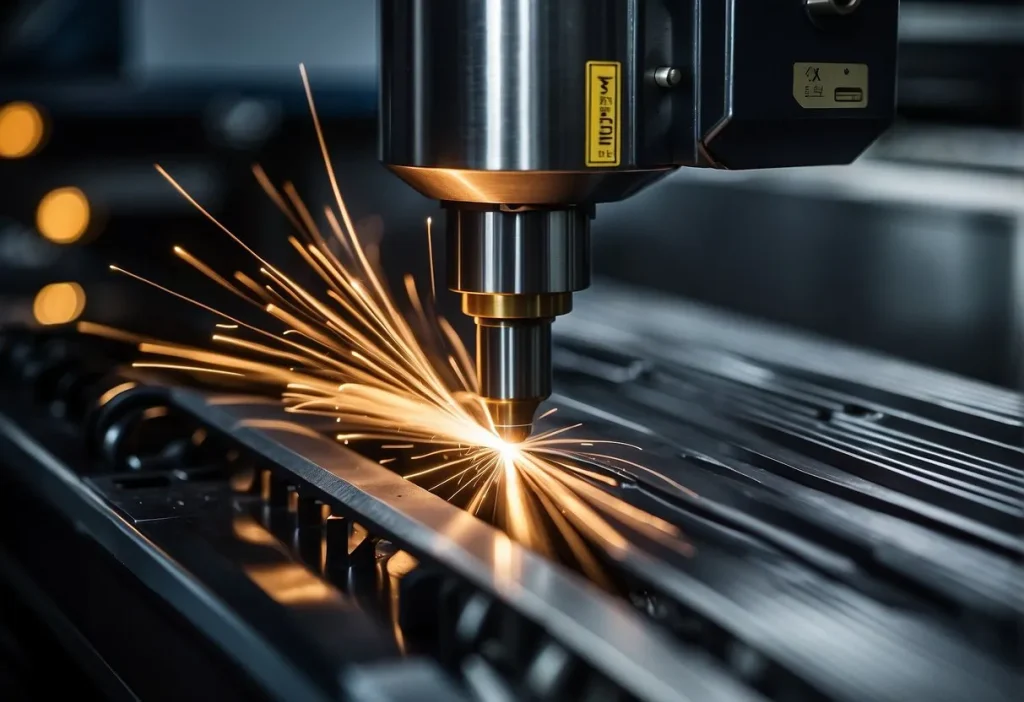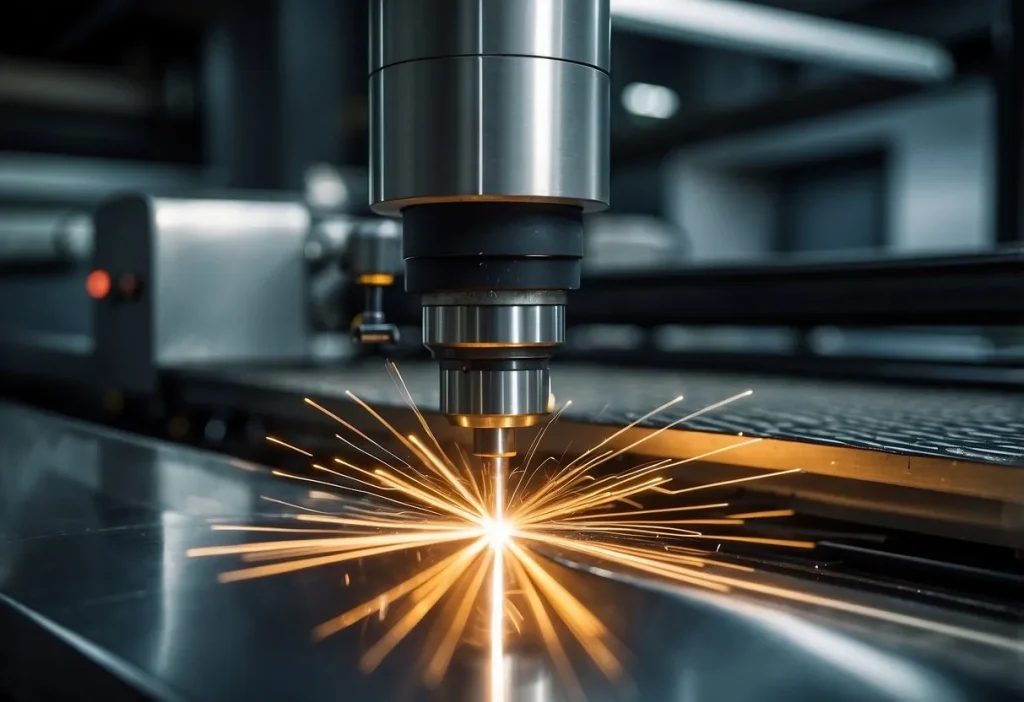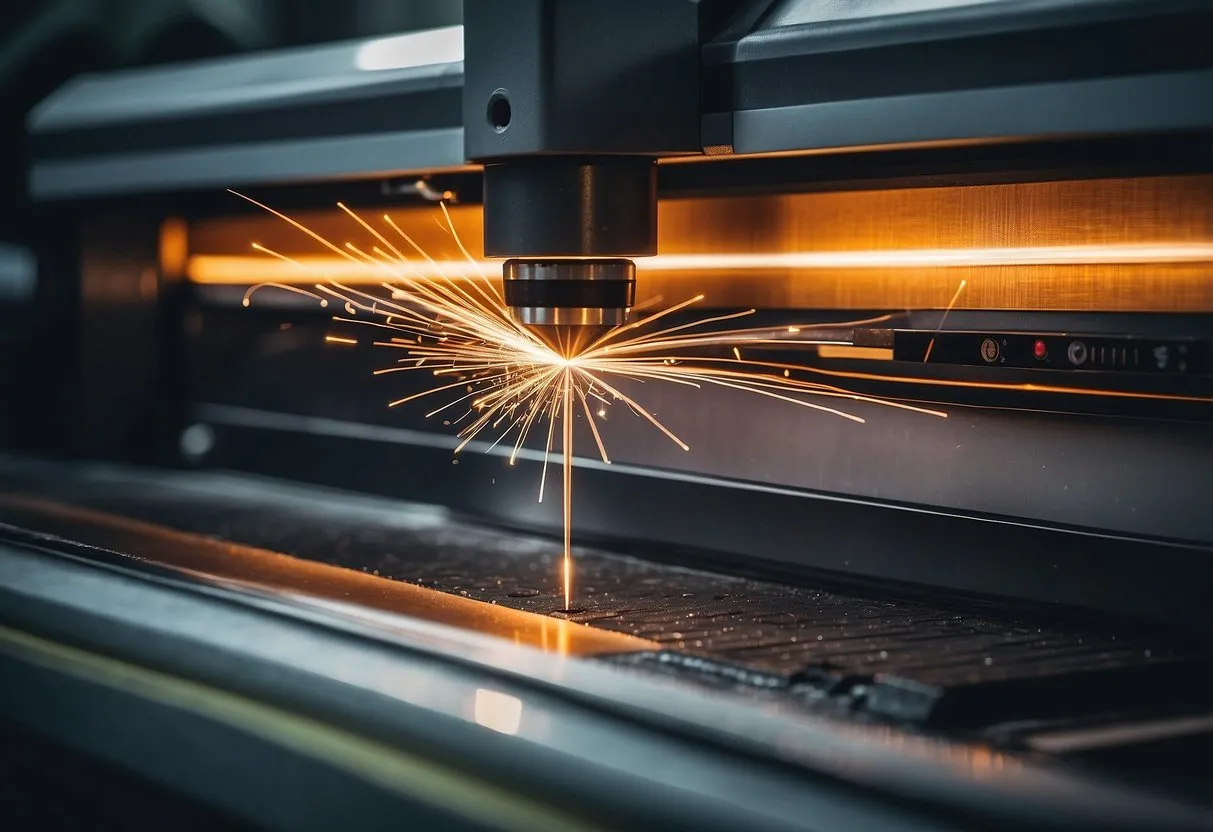We will explore the basics of how Tanaka Laser Cutting Machines operate. Key topics include the principles of laser cutting, the types of lasers used in metal fabrication, and the importance of assist gases.
The Core Principles of Laser Cutting
Laser cutting involves using high-powered lasers to cut through materials. The laser beam melts, burns, or vaporizes the material, resulting in a clean cut. Precision is achieved by focusing the laser beam to a small point, generating intense heat. We use different settings to get the best results for various materials like metals, plastics, and wood.
Types of Lasers in Metal Fabrication
There are two main types of lasers used in metal fabrication: Fiber Lasers and CO2 Lasers.
- Fiber Lasers are known for their efficiency and precision. They provide faster cutting speeds and are ideal for metals like steel and aluminum.
- CO2 Lasers are versatile and can cut a wider range of materials, including non-metals. They are often used for thicker materials but can be slower compared to fiber lasers.
Role of Assist Gases in Laser Cutting
Assist gases play a vital role in the laser cutting process. Nitrogen, oxygen, and air are commonly used.
- Nitrogen helps in achieving clean cuts by preventing oxidation.
- Oxygen boosts cutting speed by reacting with the material.
- Air can be used for cost-effective cutting, though it’s less effective than nitrogen or oxygen.
Choosing the right gas enhances the quality and precision of the cuts made by the laser cutting machine.
Optimizing Tanaka Laser Cutting Operations

To get the best results from a Tanaka Laser Cutting Machine, we need to focus on achieving precision and accuracy, making adjustments for better edge quality, and maintaining the machine for consistent cutting performance.
Achieving Precision and Accuracy
Precision and accuracy are key in laser cutting. Ensuring the control system is calibrated correctly helps maintain these qualities. We should regularly check and fine-tune the machine settings.
Using optimal settings such as correct laser power and speed settings can enhance cutting performance. We also need to verify the alignment of the laser beam to avoid any deviations that can affect the quality of the cut.
Adjustments for Improved Edge Quality
Adjusting the settings plays a vital role in achieving high edge quality. We need to adjust the focus of the laser beam to ensure it is optimal for the material being cut. Incorrect focus can result in poor cuts.
Using the correct gas pressure and type can also significantly improve edge quality. Too much or too little gas can cause irregularities. Adjusting for material type, thickness, and other properties ensures the best edge quality.
Maintenance for Consistent Cutting Performance
Regular maintenance is crucial for keeping the Tanaka Laser Cutting Machine in top condition. This includes cleaning lenses, mirrors, and other critical components to avoid any performance drops.
Replacing worn-out parts on time helps us maintain efficiency and extend the machine’s lifespan. Keeping a maintenance schedule and conducting routine inspections ensures consistent performance.
Organizing and using logbooks for recording maintenance tasks helps us track and schedule future maintenance activities effectively.
Consistent monitoring of machine output allows us to detect potential issues early, ensuring our operations run smoothly and effectively.
Material Considerations for Effective Laser Cutting

The type and thickness of the material greatly influence the results of laser cutting. Thermal conductivity also plays a crucial role in the precision and quality of the cut.
Influence of Material Type and Thickness
Different materials react uniquely to laser cutting. Stainless steel, mild steel, and carbon steel are commonly used metals. They are popular because they cut cleanly with minimal burr.
Aluminum and brass are more reflective, which can affect the laser’s effectiveness. Extra precautions are needed to prevent reflection damage. Copper shares similar reflective properties.
Material thickness also affects the cut. Thicker materials may require more power and multiple passes to achieve a clean cut. Surface coatings on materials can add a level of complexity, potentially requiring adjustments to laser settings.
Cutting material efficiently reduces waste and optimizes quality.
Impact of Thermal Conductivity on Quality
Thermal conductivity determines how heat is distributed in the material during cutting. Materials like aluminum and copper have high thermal conductivity, dissipating heat quickly. This can sometimes cause unwanted melting or warping.
Materials like stainless steel and mild steel have lower conductivity, allowing more precise cuts without extensive heat damage.
When cutting materials with different thermal conductivities, adjusting the laser’s speed and power settings helps improve the quality. It’s crucial to monitor and control these factors to minimize material waste and ensure clean edges. Using a thermal conductivity chart can help make these adjustments more accurate and efficient.
Technical Adjustments for Cut Quality
To achieve optimal cut quality with the Tanaka Laser Cutting Machine, we must fine-tune several technical parameters. Key areas to focus on include laser focus and beam quality, and assist gas flow and pressure.
Factors Impacting Laser Focus and Beam Quality
Ensuring the laser focus is sharp and the beam quality is high is critical. We should start by inspecting the lens for any dust or damage, as this can cause scattering of the laser beam.
The distance between the cutting head and the material must be correctly set. A beam alignment tool can help verify the path of the laser. We should regularly check the temperature of the machine to avoid overheating, which can distort the beam.
Managing the laser power and cutting speed is important. Higher power increases heat, which can lead to burning. Slower speeds can cause melting, while faster speeds may result in an incomplete cut. Finding the right balance is crucial.
Settings for Assist Gas Flow and Pressure
Assist gas helps in clearing molten material during cutting. Gas pressure and flow rate need to be accurately controlled. We should use a pressure regulator to keep the gas at optimal levels. The type of gas used (e.g., oxygen, nitrogen) also impacts cut quality.
Incorrect air pressure can cause jagged edges or burns. We need to monitor the flow to ensure it’s neither too high nor too low. Nozzle size and position can further affect the cutting speed and precision.
By carefully adjusting these parameters, we can significantly improve cut quality and precision. Regular maintenance checks ensure consistent machine performance.
Operational Excellence and Cost Efficiency
In our Tanaka laser cutting machine operations, achieving operational excellence and cost efficiency requires balancing cutting speed and quality while minimizing waste and energy use.
Balancing Speed and Quality for High Productivity
Maintaining high productivity involves finding the right balance between speed and quality. When cutting intricate designs, we must ensure that faster speeds do not sacrifice the precision of the edges. Our focus is on achieving narrow kerf width to ensure clean and precise cuts.
For various sizes and materials, like metal, it’s crucial to adjust the machine settings appropriately. Different materials might require different speeds to maintain cutting quality, and we always monitor and adjust these parameters carefully.
Regular maintenance of the machine also plays a key role in balancing speed and quality. Well-maintained equipment ensures consistent performance and reduces the likelihood of errors that could slow down our operations or compromise the quality of our cuts.
Reducing Costs Through Minimized Waste and Energy Use
Reducing costs starts with minimizing waste. Efficient material usage means planning cuts meticulously to maximize the use of each piece of material. By strategically nesting designs, we can reduce the scrap produced, which translates directly into cost savings.
We also aim to cut down on energy usage. Energy-efficient machine settings and using the machine during off-peak hours can significantly lower operating costs. Implementing automated features can also reduce energy consumption and improve productivity.
Tracking and analyzing these aspects consistently helps us identify areas for further cost reduction. By keeping a close watch on material and energy use, we ensure that we are implementing the most cost-effective methods available.




